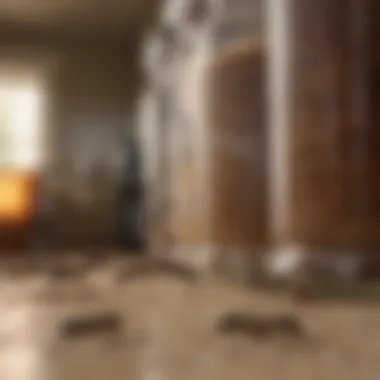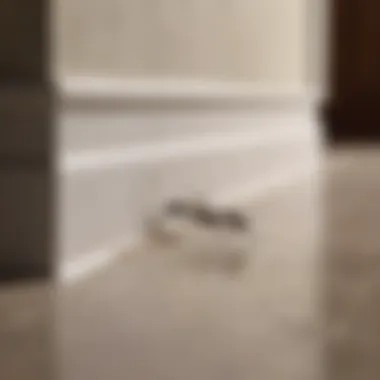Strategies to Eradicate Odorous House Ants Effectively


Preventive Pest Control Strategies
When it comes to maintaining a pest-free environment in your home, implementing preventive pest control strategies is paramount. Starting with safeguarding the exterior of your house, make sure to inspect for any cracks and crevices that serve as potential entry points for odorous house ants. Sealing these gaps using appropriate sealants and clearing debris around the perimeter can significantly reduce the chances of pests entering your living space. Furthermore, proactively managing yard maintenance through regular mowing, weeding, and trimming can help eliminate hiding spots for pests. By ensuring a well-kept yard and implementing pest prevention methods, you can minimize the risk of ant infestations from the outdoors.
Inside your home, maintaining cleanliness is crucial in deterring pests, including odorous house ants, from setting up camp. Expert cleaning tips and techniques involve meticulous attention to detail, concentrating on areas where food particles might accumulate, contributing to an attractive environment for ants. In addition to regular cleaning routines, proper garbage disposal is essential. Efficient waste disposal methods such as using sealed containers and promptly removing trash can prevent odorous house ants from being drawn to your home.
Apart from these fundamental preventive measures, exploring other innovative pest prevention strategies can further fortify your defenses against ant invasions. These may include installing tight-fitting screens on windows and doors, using natural repellents like citrus peels or peppermint oil, and maintaining a clutter-free living space to minimize potential ant nesting areas. By combining these various preventive pest control strategies, you can create a robust barrier that reduces the likelihood of odorous house ants infesting your home.
Understanding Odorous House Ants
Characteristics of Odorous House Ants
Identifying Features
Odorous house ants are identified by their distinct odor resembling rotten coconut when crushed. This characteristic odor helps distinguish them from other ant species, aiding in accurate identification for proper treatment. Their small size, dark brown to black coloration, and segmented body make them recognizable, while their scavenging behavior and preference for sugary foods contribute to their nuisance factor. Understanding these identifying features is essential for implementing targeted elimination strategies, ensuring long-term ant control and household hygiene.
Behavioral Patterns
Odorous house ants exhibit trailing behavior, forming well-defined foraging paths between food sources and nesting sites. Their ability to exploit tiny cracks and crevices for entry into homes increases the challenge of eradication, emphasizing the need for thorough inspection and proactive prevention measures. By comprehending the behavioral patterns of odorous house ants, individuals can effectively disrupt their colonies, reducing infestation levels and promoting a pest-free living environment.
Habitat and Nesting Sites
Preferred Environments
Odorous house ants thrive in moist environments, making kitchens, bathrooms, and areas with water sources ideal nesting spots. Their attraction to sugary substances encourages infestations in pantries and food storage areas, posing a hygiene risk and food contamination. Knowing their preference for warm, humid spaces allows homeowners to target these areas for treatment, minimizing ant populations and safeguarding their living spaces against recurrent infestations.
Common Nesting Areas
Common nesting sites for odorous house ants include wall voids, insulation, and under sinks, providing access to food and moisture essential for colony survival. By targeting these common nesting areas with preventive measures and elimination strategies, individuals can disrupt ant colonies, preventing their spread and protecting household hygiene. Understanding the prevalent nesting habits of odorous house ants is key to effective control and long-term management, ensuring a pest-free home environment for residents.
Detection and Confirmation


In the quest to effectively eliminate odorous house ants, the crucial step of detection and confirmation plays a pivotal role. Understanding the signs of ant infestation is essential in devising a targeted eradication plan to eradicate them successfully. By identifying the presence of odorous house ants early on, homeowners can prevent the escalation of the issue and address it promptly. Detection allows for a proactive approach towards pest control, helping individuals protect their living spaces from potential harm and nuisance. Confirming the type of ant species infesting the premises is also vital for choosing the most effective eradication methods, ensuring a comprehensive approach to eliminating the pests.
Signs of Infestation
Trails and Entry Points:
Trails and entry points are significant indicators of odorous house ant infestations. These ants leave distinctive scent trails as they forage for food, leading them to potential entry points in homes. Identifying these trails can reveal the extent of infestation and help homeowners pinpoint areas where ants are actively congregating. Observing ant trails provides valuable insights into the ants' movement patterns, enabling targeted interventions to disrupt their pathways and limit their access to resources. By understanding and tracking these trails, residents can strategize their eradication efforts effectively towards eliminating ant colonies.
Visual Identification:
Visual identification is a key component in confirming odorous house ant infestations. Recognizing the physical characteristics of these ants, such as their dark brown to black color and distinct coconut-like odor when crushed, aids in accurately identifying them. Visual inspection of areas where ants are commonly found, such as kitchens and bathrooms, can offer visual confirmation of their presence. This method reinforces the need for prompt action and empowers homeowners to initiate appropriate pest control measures to address the infestation. Visual cues serve as concrete evidence of ant activity, prompting decisive measures to eradicate odorous house ants efficiently.
Preventive Measures
Preventive measures play a crucial role in eradicating odorous house ants from your living environment. By implementing strategic methods to deter these pests, you can effectively curb infestations and maintain a pest-free home. In this article, we delve into specific elements and benefits of preventive measures, emphasizing the significance of proactive pest management.
Maintaining Cleanliness
Sealing Food Sources
Sealing food sources is a key aspect of pest control, especially when combating odorous house ants. By ensuring that all food items are stored in airtight containers and cleaning up spills promptly, you can eliminate attractants for these pests. The key characteristic of sealing food sources lies in depriving ants of a food supply, thus disrupting their foraging patterns. This method is popular due to its non-toxic nature and effectiveness in deterring ant colonies. While sealing food sources can be time-consuming, the long-term benefits of preventing infestations make it a worthwhile choice. Proactively sealing food sources not only discourages ants but also promotes overall hygiene in your home.
Proper Waste Disposal
Proper waste disposal is integral to preventing odorous house ant infestations as it removes potential food sources and odors that attract these pests. By securely sealing trash bags and disposing of them regularly, you can limit ant access to food residues. The key characteristic of proper waste disposal is the removal of organic matter that could entice ants into your living space. This method is a popular choice in pest management because it addresses one of the primary factors that draw ants indoors. While proper waste disposal requires diligence, its advantages in reducing ant populations and maintaining cleanliness cannot be overstated.
Eliminating Entry Points
Sealing Cracks and Crevices
Sealing cracks and crevices in your home is a proactive measure to prevent odorous house ants from gaining entry. By sealing off potential access points with sealants or caulking, you can create a barrier that restricts ant movement. The key characteristic of sealing cracks and crevices is blocking off pathways that ants use to infiltrate your home. This method is beneficial as it not only deters ants but also helps in reinforcing the structural integrity of your residence. While sealing cracks and crevices may require time and effort, the long-term advantages of preventing ant invasions justify the undertaking.
Repairing Screens


Repairing screens on doors and windows serves as a preventive measure against odorous house ants, preventing their entry into your home. By fixing any tears or holes in screens, you create a barrier that impedes ant intrusion. The key characteristic of repairing screens is safeguarding entry points that ants commonly exploit. This method is popular for its simplicity and effectiveness in warding off ants while allowing ventilation. Though repairing screens may necessitate minor repairs, the advantages of restricting ant access and maintaining an insect-free environment make it a valuable investment in pest prevention.
Natural Remedies
In the realm of effectively eliminating odorous house ants, natural remedies play a crucial role. These eco-friendly solutions not only help in eradicating ant infestations but also contribute to creating a safe and non-toxic environment for households. By opting for natural remedies, individuals can avoid exposure to harmful chemicals found in conventional pest control products, making it a popular choice among those seeking a more sustainable approach to pest management. Additionally, natural remedies often provide cost-effective solutions that can be easily prepared and applied at home without the need for professional assistance.
White Vinegar Solution
Preparation and Application
When delving into the specifics of preparation and application of the white vinegar solution, it is essential to note its significance in effectively combating odorous house ants. The key characteristic of this mixture lies in its simplicity and accessibility, as white vinegar is a common household item that can be readily found in most kitchens. Its acidic properties act as a natural repellent for ants, disrupting their scent trails and deterring them from entering living spaces. This cost-effective and easy-to-make solution offers a convenient method for individuals looking to address ant infestations promptly.
Effectiveness
The effectiveness of the white vinegar solution in eliminating odorous house ants cannot be understated. Its ability to disrupt ant communication and foraging patterns makes it a valuable tool in ant control efforts. Moreover, its non-toxic nature ensures the safety of household members and pets, aligning with the preference for environmentally friendly pest management solutions. While the smell of vinegar may be off-putting to some, its powerful repelling properties make it a highly beneficial choice for those seeking natural and sustainable ways to address ant infestations.
Peppermint Oil Spray
Usage Instructions
When considering the usage instructions for peppermint oil spray in combating odorous house ants, one must recognize its role in the overall goal of eliminating unwanted pests. The key characteristic of this spray lies in its pleasant aroma, which serves a dual purpose of repelling ants while leaving behind a fresh scent in treated areas. Household members can easily apply peppermint oil spray by diluting the oil in water and using a spray bottle to target ant entry points or common infestation areas. This user-friendly application method makes peppermint oil spray a popular choice for individuals looking to manage ant populations without resorting to harsh chemicals.
Repellent Properties
The repellent properties of peppermint oil contribute significantly to its effectiveness in deterring odorous house ants from invading living spaces. The strong scent of peppermint disrupts ants' sensory abilities, making it challenging for them to navigate and locate food sources within household premises. As a natural repellent, peppermint oil offers a safe and environmentally friendly alternative to synthetic insecticides, mitigating the risks associated with prolonged exposure to toxic substances. While peppermint oil spray may require reapplication to maintain its efficacy, its long-lasting effects make it an attractive option for those seeking a sustainable approach to pest control.
Chemical Treatment Options
In the battle against odorous house ants, chemical treatment options play a significant role in effectively eradicating these pesky pests. When dealing with an infestation, it is crucial to consider the specific elements that make chemical treatments a vital part of pest control strategies. Chemical treatments offer a targeted approach to eliminating ant colonies, providing a quick and efficient solution to ant infestations. By incorporating chemical treatment options into your pest control plan, you can effectively disrupt the ant population and prevent future infestations. A key benefit of chemical treatments is their ability to tackle ant colonies at the source, ensuring a thorough and lasting solution to the problem. It is essential to carefully consider the selection of chemical products, ensuring they are safe for indoor use and effective against odorous house ants.
Bait Stations


Application Methods
When discussing the application methods of bait stations in ant control, it is essential to highlight their strategic placement and utility in attracting and eliminating ants. Bait stations work by luring ants with bait that contains toxic substances, which are then carried back to the colony, effectively targeting and eradicating the entire ant population. The key characteristic of bait stations is their ability to deliver a slow-acting poison to the ants, allowing them to transport the toxin to other members of the colony, ultimately leading to the collapse of the ant population. This method is particularly beneficial for this article as it offers a targeted approach to ant control, minimizing the environmental impact and ensuring the safety of household residents. A unique feature of bait stations is their ability to effectively control ant infestations without requiring extensive spraying of chemicals in living spaces, making them a popular and efficient choice for combating odorous house ants.
Impact on Ant Colonies
The impact of bait stations on ant colonies is a crucial aspect to consider when implementing chemical treatment options. Bait stations are designed to disrupt the reproductive cycles of ants and reduce their population by targeting the queen and worker ants. By infiltrating the colony with toxic bait, bait stations effectively eliminate ant colonies from within, preventing reinfestations and maintaining long-term control over ant populations. A key characteristic of bait stations is their ability to provide a sustainable solution to ant infestations by decimating colonies at their source. This method is highly beneficial for this article as it offers a comprehensive approach to ant control, ensuring the eradication of odorous house ants while minimizing environmental impact and maintaining household safety.
Insecticidal Sprays
Choosing Effective Products
When considering insecticidal sprays for ant control, selecting effective products is paramount to achieving successful eradication of odorous house ants. The key characteristic of effective insecticidal sprays lies in their ability to target and kill ants upon contact, providing immediate relief from ant infestations. Choosing products that contain potent active ingredients such as pyrethroids or neonicotinoids can ensure the efficient elimination of ants while being safe for indoor use. The unique feature of insecticidal sprays is their versatility in treating both visible ants and hidden ant colonies, offering a comprehensive solution to ant infestations. While effective products can significantly reduce ant populations, it is essential to follow safety guidelines and recommendations to minimize exposure to harmful chemicals and protect household members.
Safety Precautions
Implementing safety precautions when using insecticidal sprays is imperative to safeguarding household residents and pets while effectively controlling ant infestations. The key characteristic of safety precautions is their role in minimizing potential risks associated with chemical exposure and ensuring the responsible use of insecticides. By following proper application guidelines and using protective equipment such as gloves and masks, individuals can reduce the likelihood of adverse health effects from insecticidal sprays. The unique feature of safety precautions is their focus on environmental safety, promoting the sustainable use of chemical treatments to achieve pest control goals. While insecticidal sprays offer efficient ant eradication, it is essential to prioritize safety measures to prevent unintended consequences and maintain a healthy living environment.
Professional Extermination Services
When dealing with a persistent odorous house ant infestation, turning to professional extermination services can be a game-changer. These experts bring a wealth of knowledge and experience to the table, offering specialized solutions that can effectively rid your living space of these troublesome pests. Their intervention goes beyond just eliminating the visible ants; it involves a thorough assessment of the infestation, targeting the root cause to prevent future occurrences.
By opting for professional extermination services, you can benefit from tailored treatment plans that are designed to suit your specific needs. These plans are comprehensive and take into account factors such as the extent of the infestation, the layout of your home, and any unique challenges present. The expertise of professionals ensures that the treatment is not only effective but also safe for your family and pets.
One of the key considerations when engaging professional services is the reassurance of a job well done. These professionals have access to a range of advanced tools and techniques that are not readily available to consumers. Their in-depth knowledge of pest behavior and ecology allows them to devise strategies that are highly targeted and efficient, minimizing the risk of re-infestation.
Benefits of Hiring Experts
Thorough Inspections
Thorough inspections are a cornerstone of professional extermination services. These meticulous assessments involve a detailed examination of your property to identify entry points, nesting sites, and ant trails. By pinpointing these key areas, experts can formulate a precise treatment plan that effectively targets the heart of the infestation.
The significant advantage of thorough inspections lies in their ability to uncover hidden or hard-to-detect ant colonies. This detailed approach ensures that no stone is left unturned, leading to a comprehensive eradication of odorous house ants from your home. Moreover, by addressing the root cause of the infestation, thorough inspections pave the way for long-term pest control solutions.
Customized Treatment Plans
Customized treatment plans are tailored to address the specific needs of your infestation. These plans take into consideration factors such as the severity of the problem, the layout of your home, and any preferences you may have regarding pest control methods. By tailoring the treatment to your unique situation, professionals can deliver targeted solutions that yield optimal results.
The key benefit of customized treatment plans is their adaptability. Professionals can adjust the treatment strategy based on the response of the ants, ensuring maximum efficacy. This personalized approach not only boosts the chances of successful eradication but also minimizes the environmental impact of pest control measures. Additionally, by offering a customized solution, experts can address any concerns or preferences you may have, providing a more satisfying and effective ant elimination process.



